iPad 4 (Late 2012) Review
by Anand Lal Shimpi on December 6, 2012 4:40 PM ESTCPU Performance
Like the A6, the 4th generation iPad's A6X integrates two custom designed Apple Swift CPU cores that implement the ARMv7 instruction set. The two cores share a 1MB L2 cache, just like they do in the iPhone 5's A6. I spent a lot of time characterizing the architecture and performance of Swift in our iPhone 5 review, so I won't go over a lot of that here. What I will say is that Swift manages to be the best balance of performance and power efficiency in an ARM based CPU core available today. Swift looks a lot like Apple's take on Qualcomm's Krait core. It's not a Cortex A15 competitor from a performance standpoint, but likely a more power efficient design.
Unlike what we saw in the previous iPads, the A6X only boasts a marginal increase in max clock speed (~7%) over the A6. The two Swift cores can run at up to 1.4GHz in the A6X compared to 1.3GHz in the A6.
| Apple iPhone/iPad CPU Clock Comparison | |||||
| iPhone | iPad | iPad Frequency Advantage | |||
| Apple A4 Generation | 800MHz | 1.0GHz | 25% | ||
| Apple A5 Generation | 800MHz | 1.0GHz | 25% | ||
| Apple A6 Generation | 1.3GHz | 1.4GHz | 7.7% | ||
CPU performance improves substantially over the 3rd generation iPad thanks to the Swift cores. Unfortunately, big gains in CPU performance aren't always apparent in actual use. The iPhone 5 seemed to subjectively gain more from the move to A6, partially because of just how frequency constrained the A5 in the 4S was. The A5X CPUs in the iPad 3 were already running 25% faster than the A5's CPU cores.
I didn't notice appreciable differences in application launch times, but there are a few areas were the faster CPU cores definitely stand out. Auto enhance in iPhoto completes quicker on the iPad 4 vs. its predecessor. This is especially true for work on large (high MP) images. I don't think a pair of Swift cores is all it takes to make the iPad 4 a suitable photo retouching workstation but it's better than the previous model.
| General Use CPU Performance Comparison | |||||
| iPad 2/mini | iPad 3 | iPad 4 | |||
| iPhoto Auto Enhance 36MP JPG | 11.7 seconds | 12.0 seconds | 9.1 seconds | ||
| Batman: The Dark Knight Rises Level Load Time | 36.3 seconds | 35.9 seconds | 31.1 seconds | ||
Scrolling around iOS Maps in 3D view is substantially smoother on the 4th gen iPad compared to its predecessor. We noticed something similar in our comparison of the iPhone 5 and 4S. Web pages do load quicker on the iPad 4, although the differences can be small depending on the complexity of the page in question. The real world responsiveness benefit from the faster CPU cores seems to be in the 10 - 30% range depending on what you're doing. The problem is at the lower end of the scale, it can be difficult to really feel if you're comparing the 3rd and 4th gen iPads.
We're still very limited in good, cross-platform CPU benchmarks. We, once again, turn to JavaScript tests run in the browser. For all of the tablets tested here we're using Chrome for Android and Mobile Safari for iOS.
SunSpider has been a part of all of our mobile performance testing for quite a while now. It's not the perfect benchmark, but the test ends up being a good measure of browser performance as well as cache latency and CPU performance.
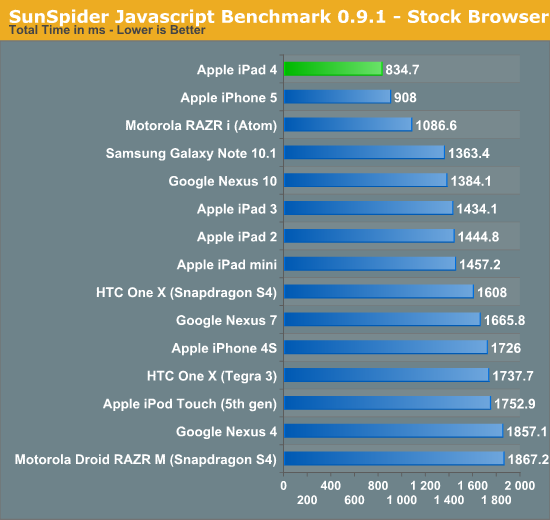
The Swift cores do an excellent job here thanks to their much improved memory performance. The Nexus 10 should be competitive however the current state of browser optimizations hold it back a bit here.
Google's Octane benchmark is a much larger test than SunSpider, but we're still looking at JavaScript performance. Octane includes all 8 of the tests from Google's older V8 benchmark but adds 5 new ones including a PDF reader, 3D bullet physics engine and portable 3D game console emulator all built in javascript.
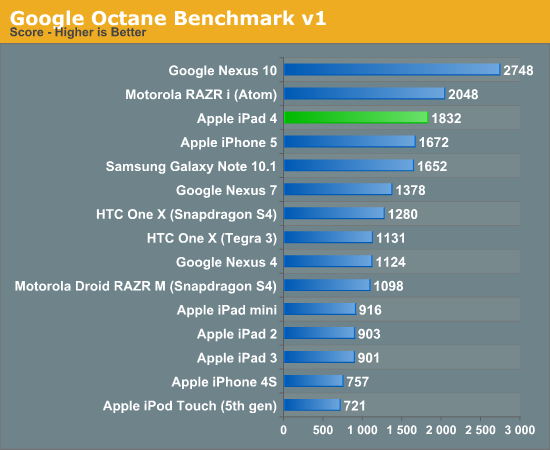
Octane tells a very different story. The iPad 4 does very well, but the Nexus 10's Cortex A15s are really allowed to shine here. The A15 is simply in a different league of performance.
Finally we have Kraken, a seriously heavy javascript benchmark built by Mozilla. Kraken focuses on forward looking applications that are potentially too slow to run in modern browsers today. The result is much longer run times than anything we've seen thus far, and a very CPU heavy benchmark:
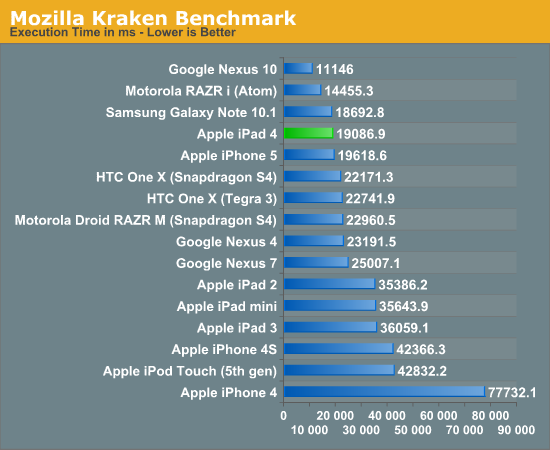
We see a similar story with Kraken. Apple improved CPU performance tremendously over the iPad 3, but the Nexus 10 is able to reach new heights.
Why don't we see a direct correlation between these CPU bound js tests and the real world performance numbers I mentioned above? The problem is that most of today's iOS apps are really built for the sort of performance that a pair of Cortex A9s can deliver. I see pockets of CPU bound activity but it's not consistent enough where you're going to necessarily see a dramatic improvement in responsiveness across the board. I do believe the gap is more apparent on the iPhone thanks to the huge difference in frequency between the 4S and 5, but on the iPad the range from subtle to noticeable differences is broader.
Memory Bandwidth
A look at Chipworks' die shot reveals the same memory interface arrangement as we saw in the A5X:
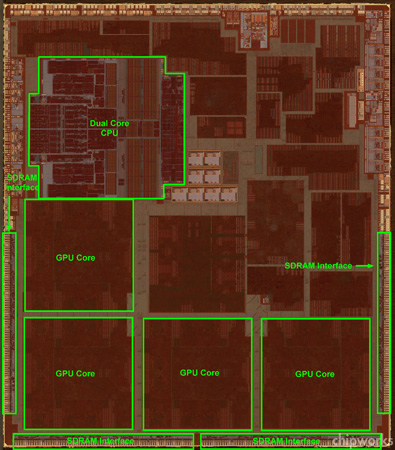
Apple A6X die via Chipworks
The A5X/A6X place the memory interface blocks (and perhaps the controllers themselves?) adjacent to the GPU, while the A5/A6 more tightly integrate the CPU and memory controller. This highlights a pretty substantial difference in priority between the A5/A6 and A5X/A6X SoCs. The latter really do prioritize memory bandwidth delivery to the GPU, and for good reason. The Retina Display equipped iPads have over 4x the number of pixels as the iPhone 5.
The 4th generation iPad that iFixit took apart had 1GB of Hynix LPDDR2-1066 on-board, which would indicate a small increase in memory bandwidth. Just as we saw with the A5/A5X comparison, the additional memory bandwidth doesn't appear to be available to the CPU cores - only the GPU cores.


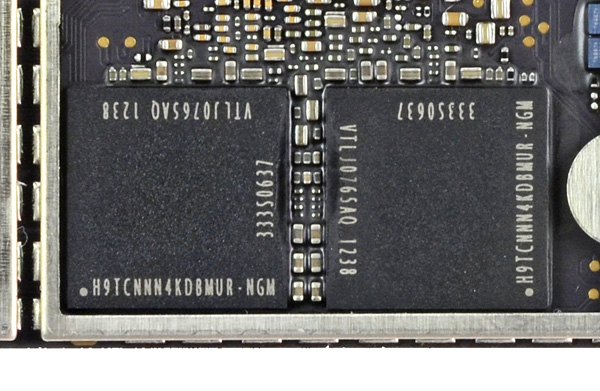
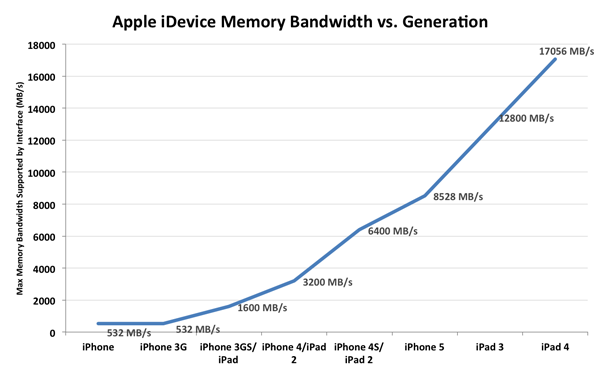








113 Comments
View All Comments
seapeople - Thursday, December 6, 2012 - link
How late would this review have had to be for you not to post that comment? In fact, I bet I you typed that comment up the moment you heard about the Ipad release, saved it in a Word document, and patiently waited to post it on the Ipad review that would obviously be coming.The fact that Anand is practically the last tech site on the planet to actually post a review of the new Ipad makes it extremely ironic that you use this action to insinuate that Apple is paying Anand off.
Oh well, it makes sense considering you can't even spell your own name right.
bplewis24 - Thursday, December 6, 2012 - link
It would be great to see the same image/resolution/detail comparisons that you did with the iPad iterations done with the iPad4 vs the Nexus 10 when it's ready.Zink - Thursday, December 6, 2012 - link
I agree. You don't need to do it with every new tablet but it is a good opportunity to do some really in depth head to head iOS vs Android on 10" tablets. We all know this iPad is basically like the last one. What is harder to understand and get data on is completely different products.daar - Thursday, December 6, 2012 - link
Would be nice to see in future reviews, can help get an idea of quality control and calibration, despite what Apple guarantees.Zink - Thursday, December 6, 2012 - link
"I no longer have a 45nm iPad 2 so forgive me for the incomplete dataset here (it's safe to say that the iPad 2 would at least equal the iPad 4 in battery life, if not exceed it)"That doesn't seem safe at all from the numbers you gave. The 45nm iPad 2 only hits 10.1 hours in the 4th gen battery rundown and it is going to take a big drop with the new test. The iPad 3 sees a 12% hit to battery life with the switch to the new smartphone web browsing battery life test. Both tests should use the same screen settings so the increased energy consumption is coming from the 45nm silicon and radio. Screen res and GPU energy consumption does not significant contribute to this decrease in runtime because it is a browser test. The iPad 4 is also able to improve on the newer test despite its high res. Crunching the numbers, the iPad 3 is using 600 mW more to run the new test. The iPad 2 uses a bit older tech inside so I would assume it needs a similar increase in energy, putting the 45nm iPad 2’s performance in the new battery life test at around 8.2 hours, possible worse.
Zink - Thursday, December 6, 2012 - link
I didn't see you had the iPad mini numbers there too. Even it sees a small hit on the new test so the iPad 3 GPU isn't what is hitting battery life the hardest. I would be surprised if the 45nm iPad 2 can do even 8.5 hours, assuming these battery rundown tests are fairly accurate.Velius - Friday, December 7, 2012 - link
Author states, "I've viewed the divide there as a line separating a computing device from an appliance. There's overlap in capabilities, but the overall experience tends to fall along those lines for me."This is a false meme that keeps getting propagated. Android is just as much of a walled garden as iOS, and I'm not talking about the App Store. I mean the functionality of the OS. Android is usually touted as having a lot more customizability than iOS, but this is an illusion. Sure, there are context-sensitive menus which are nice and all, but what you can and cannot do with them are a function of the app maker. It's like having a choice between Coke and Pepsi: you think you have a choice, but your options have been severely constrained. I've used both iOS and Android, the latter mainly to see what all the hype was about (as I am a Linux geek too, though prefer OS X for day-to-day), yet was astounded and shocked when I eventually tried it (on a SGS3 which I am now selling). Where was the full customizability? Where was this amazingly flexible system with tons and tons of features, bells, whistles, and doodads? It's just a copy of iOS! You have apps, and you run one at a time. That's just about it!
As in many other things, Apple leads, and the rest (Google, Samsung, et al.) follow. Everyone forgets that when the iPad was first rumored, speculations were rife with regards to the capabilities of its OS. Many in the tech world wanted a full-blown OS X experience on the iPad (the name wasn't revealed back then of course). Yet they got the "appliance" that iOS on the iPad is. And yet, instead of forging its own path by introducing a full-blown Linux system on a tablet or phone, Google chose to copy and reproduce the appliance aspect of iOS in Android. Only now is Canonical actually moving to port Ubuntu to phones/tablets, well it's really an Android/Ubuntu hybrid but you actually get a full desktop when you dock it. *That* I'm looking forward to.
So Android is just as much of an appliance as iOS, and iOS is just as much of a computing device as Android, if not more so. Yes, I'm talking about the superiority of the App Store - both in terms of quantity and quality. I have never seen a "killer app" in the Play Store that is also not present in the App Store (or with a better version). But ooh boy is it the case the other way around. There are some specialized scientific apps I use for research that just plain don't exist in Android. E.g., X-Windows Phase Plane (XPP) on the iPad:
https://itunes.apple.com/us/app/xpp/id433859546?mt...
Furthermore, of the apps that do get released for both Android and iOS, they generally work better in iOS. These considerations are in fact the main reason why I stick to Apple. The Nexus 10 et al. may be sexier in terms of hardware, but without good software, they are just not as functional.
The level of Android fanboyism on the Internet truly astounds me. The gall, to claim that Android is a "computing device", and iOS an "appliance"! Like it's Cray supercomputer vs. a toaster! How astoundingly ridiculous! Unfortunately, even though this meme is groundless, it will keep getting propagated, ironically mostly due to the tech/geek "cred" that Android fanboys confer onto themselves, failing to realize that they are not the only ones with such cred. Heck, iOS fanboys are also Linux users. (You're looking at one right here.) I wonder, though, how many Android fanboys are *really* computer savvy?
Comments like the ones the author made, and that inspired this post, make me wonder otherwise.
Velius - Friday, December 7, 2012 - link
Sorry about the vitriolic nature of that post. I'd erase and restart if I could.All I wanted to say is that modern tablets are pretty uniform in their capabilities and interfaces, so "computing device" vs "appliance" is a false distinction. Either they are all appliances, or all computing devices. (I see it as both.)
In any case, great review. I will echo what someone else said, that it's a real treat to have a review of the iPad 4 in particular especially as it's not that different than the iPad 3.
Keep up the good work. :)
DeciusStrabo - Friday, December 7, 2012 - link
What exactly are you missing in terms of customization of Android? I mean, you can go and switch out basically everything you want, Kernel, drivers, UI, functionality. You can add any software you want from any point you want (alternative App shops, your own developers, your own Linux/OS X machine). You can add your own codecs, drivers, functions. You can automate basically any part of the system if you so desire. So what are you missing exactly?Sufo - Friday, December 7, 2012 - link
I have to agree with DeciusStrabo. You really aren't getting the most out of your android device if you can't see the distinction between iOS and Android (this coming from someone who thinks both are pretty shitty). There are many many things you can do with Android _devices_ that you can't do with an iphone. Try flashing custom roms for example. You _can_ change pretty much every aspect of an Android device - assuming you can root it. Can you run full OS VMs in iOS? I don't know, but I know you can with Android. In terms of apps, mxplayer is better than any iOS video player, and poweramp is better than any audio player - I'd say these are pretty good wins (at the same time, iOS default audio player shits on the Android default). That's not to say I disagree with you - iOS certainly has the edge often (app-wise), but your conclusions about Android are unfair and not accurate.So yes, a stock manufacturer Android experience is much closer to iOS than many people would like to admit (though it *is still* more of a computing device for sure). However if you know how to leverage the most out of an Android device, then there are certain powerful things it can do than an iOS device simply can't. It's essentially trading killer apps for specific device use cases, which leaves the two pretty equal overall, but with a clear favourite for most people depending on what you want out of your device.